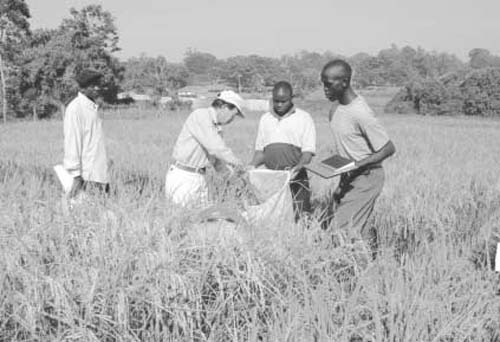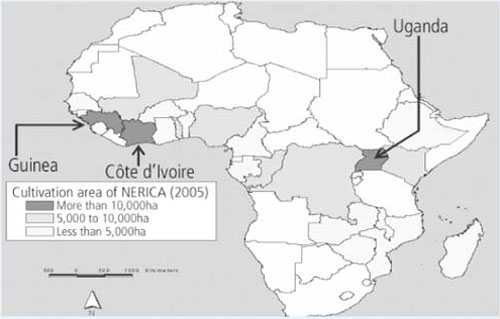Japan's Official Development Assistance White Paper 2006
Box I-2. Efforts to Disseminate New Rice for Africa (NERICA)
1. What is NERICA?
New Rice for Africa (NERICA) is a new rice species that has been developed through cross-breeding high yield-potential Asian species and African species that are resistant to diseases. It was first developed in 1994 by Dr. Monty Jones, a researcher at the West African Rice Development Association (WARDA). Japan participated in the development to create new varieties that can adapt to various different regions in Africa with diverse natural conditions. The characteristics of the NERICA varieties include: (i) they yield greater harvests than conventional species; (ii) they grow in shorter time spans; (iii) they are resistant to dry conditions (drought); and (iv) they are tolerant to diseases and vermin.
2. Why should NERICA be disseminated?
Rice keeps for a long time and can be cooked more easily than corn, potatoes, and other cereals. These factors help increase demand for rice in many African countries. However, local rice production is not enough to keep up with the rising demand, thus giving way to an increase in rice imports. Increasing yields of rice is difficult, as conventional species are low yielding and the land which is suitable for planting conventional species is limited. On the other hand, the dissemination of NERICA varieties that yield good harvests and show good tolerance to dryness will be expected to help expand rice production and raise the income of underprivileged farmers.

Experts giving technical instruction for growing NERICA varieties (Photo by JICA)
3. How far has NERICA been disseminated?
As of 2005 NERICA is said to be grown in a total area of over 150,000 hectares in Africa. In countries like Uganda and Guinea, the efforts to disseminate NERICA have just moved from the experimental phase to the phase of production by local farmers in countries where NERICA has been disseminated. In other countries, the experiments have just started, yet seed production is implemented in a few countries.

(Source: WARDA)
4. What should be addressed to disseminate NERICA?
Many people involved in ODA projects and agricultural scientists recognize the advantage of NERICA, while most farmers have little information on NERICA, which is a new variety for them. Since the variety of rice selected has an impact on farmers' incomes, farmers would act with caution in terms of adopting NERICA unless they affirm the merits of NERICA production by themselves. Thus it is important that, while raising farmers' understanding of the virtues of NERICA, the identification of varieties and cultivation techniques which are suitable for local natural conditions comes about through farmers' participatory experiments, in order to further disseminate NERICA. The promotion of seed production is also significant, because the promotion of NERICA seeds is insufficient to meet the demand of producers. Furthermore, for the improvement of post-harvest technology including threshing and milling, it is essential to sell NERICA as a commerce, and to enhance the capacity development of agricultural instructors who work for extension activities in various countries.
5. What assistance does Japan extend?
Since 1997 Japan has been providing assistance through the measures listed below in collaboration with international agencies such as the United Nations Development Programme (UNDP), the Food and Agriculture Organization (FAO), and the Consultative Group on International Agricultural Research (CGIAR), as well as non-government organizations (NGOs). Measures taken include: research and development of new NERICA varieties that fit with various climates and soil conditions in various African regions; and experimental growth, seed production, and dissemination of NERICA mainly in Uganda, Benin, and Guinea. Japan will continue its active cooperation using its know-how to further help disseminate NERICA, for seed production, improvement of post-harvest technology and capacity development of agricultural instructors.



 Next Page
Next Page